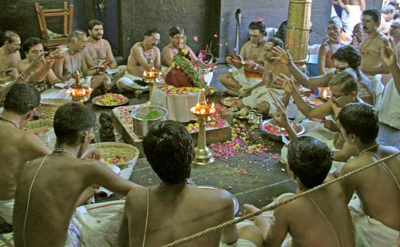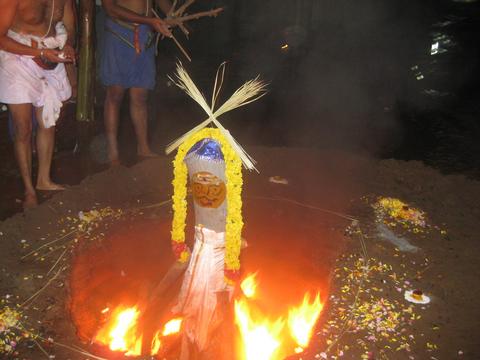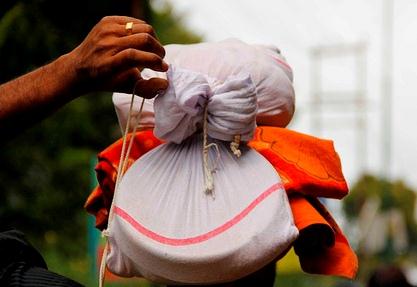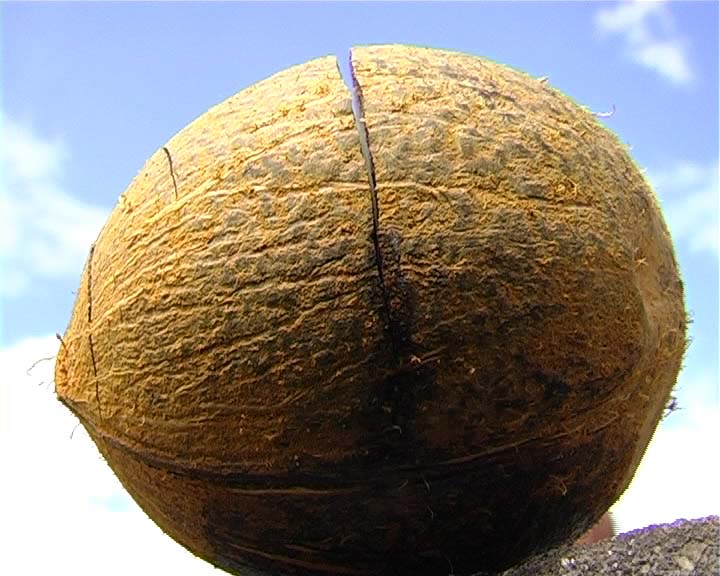Sabarimala Rituals
The Initial Rituals
Traditionally, austerities begin on the 1st of Vrischikam (mid- November) with the wearing of a Maala (rosary) of Rudraakshaor Thulsi around the neck, The pilgrim going for the first time to Sabarimala finds out a Guruswami, a preceptor-guide, who has a few years of experience of going to Sabari mala, preferably eighteen years, A pilgrim receives the rosary with a metallic pendant with the figure of Lord Ayyappa engraved on it, either from the Guruswami or a temple priest, The wearing of the rosary is symbolic of the pilgrim's spiritual training to identify himself with the Supreme Truth represented by the form of Lord Ayyappa, The Mahaa-vaak.ya (Great Saying) of the Rig-veda: 'Thath Thvam Asi' -You are That Supreme Truth -boldly inscribed on the top of the temple reminds one of this Truth.It is an opportunity for the pilgrim to apply spiritual disciplines in life, After wearing the rosary. he is expected to make an effort to transcend the limitations of his personality and its restricting expressions and moods. People, even his parents, no more call him by name, but reverentially addresses him as Swami or Ayyappa. He addresses others also as Swami and he is supposed to consider not only man, but beasts, trees and everything else essessentially Divine. When he visits any temple or any place of worship, , he chants" Swamiye saranam Ayyappa''. He considers the Deity in any temple as a different form of Lord Ayyappa only. He is supposed to look at everything, whether living or non-living, as the manifestation of the one Truth -Lord Ayyappa. The donkeys that carry the goods up the mountains to Sabarimala temple, are' Kazhutha Swami-s' (Kazhutha means donkey), Even the human excreta is referred to as 'Bhoo-Swam,", The Advaithic vision that there is nothing other than manifestations of the transcendental Reality is set to maximum practical application to decondition consciousness from its various limitations.
 During the austerities many pilgrims often do not stay at home, but prefer to stay in a hall adjacent to a temple or in special prayer halls called Bhajana-madom-s built for the purpose of group worship, singing devotional songs and so on. His food is called Bhiksha -alms. He should not entertain any worldly distinction of caste, creed, religion or occupation. For the time being, he becomes a recluse for all practical purposes. Although he is in the midst of society, he leads a very different pattern of life, relaxed and, transcendental, his mind mostly occupied with the thoughts of the Supreme Truth. He is like a Yogi living in a solitary cave in the in mountain fastness. During this period the pilgrim. usually wears blue I or black clothes with a shawl of the same color over his shoulders. If he is working in an office, he wears the dress of a Swami after office hours.
During the austerities many pilgrims often do not stay at home, but prefer to stay in a hall adjacent to a temple or in special prayer halls called Bhajana-madom-s built for the purpose of group worship, singing devotional songs and so on. His food is called Bhiksha -alms. He should not entertain any worldly distinction of caste, creed, religion or occupation. For the time being, he becomes a recluse for all practical purposes. Although he is in the midst of society, he leads a very different pattern of life, relaxed and, transcendental, his mind mostly occupied with the thoughts of the Supreme Truth. He is like a Yogi living in a solitary cave in the in mountain fastness. During this period the pilgrim. usually wears blue I or black clothes with a shawl of the same color over his shoulders. If he is working in an office, he wears the dress of a Swami after office hours. It is almost a total break from the ordinary pattern of life and this special discipline for a certain period reinforces him physically, mentally and spiritually. Some modern psychologists are of the opinion that the suppression of the sexual instinct is not advisable. According to the Yogic approach the withdrawal from indulgence in sense pleasures with the aim and effort for a spiritual breakthrough results in a healthy sublimation of sexual energy, and thus reinforces the body, mind and spirit. The pilgrim is thus availing himself an opportunity for an all-round recharging. Many pilgrims, after returning from the pilgrimage, long eagerly for the next chance.
Group-oriented Ritual
Vellam-kudiThe austere devotional efforts have both an individual and group orientation. Pilgrim groups guided by a Curuswami, engage in some group rituals during the p~riod of austerities. Vellam-kudi, which literally means drinking of water, is such a major ritual. The pilgrims assemble in the house of one of the pilgrims and the Pooja (ritualistic worship) is performed there. Rice flakes, plantain fruits, sweetened baked rice called Ada, the puffed rice called Malaru. jaggery, jaggery-water, etc., form the devotional offerings to the Lord. After the Pooja, these are distributed among the pilgrims as the Prasaadam, symbolic of Lord's Grace. The Vellam-kudi may be conducted in the houses of all the pilgrims in the group.
Padukka
Another major group-oriented ritual is known as the Padukka which involves elaborate performance of the Pooja. First, a Padukka- pandal, a temporary shed for the performance, is erected. The top of the pandal is covered with white clothes and the Pandal is decorated with mango leaves, betel leaves, flowers, fruit bunches of plantain, etc. Oil lamps are hung from the four coners, and placed on the ground also. In the centre of the Pandal there will be a Sreekovil (sanctum sanctorum) where a picturc or icon of Lord Ayyappa will be kept on an elevated platform. There will be symbolic representation of the 18 sacred steps of the Sabarimala temple and appropriate places for the accompanying Deities. There will also be an Aazhi, the heap of smouldering embers of sacred fire. The appropriate offerings will be prescribed by the Guruswami, who will be performing the elaborate Pooja.
Aazhi-pooja

One such distinctive performance is the Vilppaattu, an energetic rendering of ballads accompanied by rhythmic beating on a bow- like musical device with many bells hanging from it.
Charged with intense devotional fervor, some of the pilgrims lose themselves in ecstasy in which their sense of individuality being temporarily vanished jump into the smouldering fire and with cupped hands lift the red-hot embers and hurl them all around! Those who have made a special study of the strange t' phenomenon of fire-walking-that occurs in different parts of the world opine that it shows the hidden faculty of man to transcend unscathed the fire element in certain altered states of consciousness. It points t out the transcendental dimensions of consciousness beyond the ken of modem scientific experiments.
These ritualistic ceremonies are conducted at the houses of the pilgrims and at public places during the period of austerities. Besides these, some special ceremonies are also conducted; and there are also some ceremonies, special to certain regions.
These joint efforts through ritualistic ceremonies for `spiritual refinement bestow a sense of solidarity and brotherhood among the pilgrims.
Kettunira Ceremony
On the day fixed by the Guruswami, the pilgrims prepare themselves for the sacred journey. The most important rite just before starting the pilgrimage is the Keffunira, also known as Keffumurukku. It is the filling in of the sacred package, (Ketfu means package and Nira, filling in), which the pilgrim reverentially carries on his head. For this purpose a blue or black bag with two compartments, which is known as lrumudi, is used. This ritual is performed by the Guruswami on the day for the pilgrimage fixed by him. This filled package is known as lrumudikettu. (This Malayalam word signifies, a cloth package having two compartments to be borne on one's head). Only those who carry the lrumudikettu on the head would be allowed to climb the 18 sacred steps to the temple, as they are the ones considered to have observed the austerities and thus eligible to climb the holy steps. Other devotees have to resort to a different passage to reach in front of the sanctum sanctorum for worship.The Kettunira Ritual and the Significance of lrumudikettu
 During the Kettunira, after the initial prayers, the sacred offering of ghee (clarified cow's butter) is filled inside a coconut, the fibrous covering of which is removed. The draining of the water within the coconut through a small hole on the top and filling it with ghee is a symbolic act. It signifies the draining out of worldly attachments from the mind and filling it with spiritual aspirations. Coconut is called Thenga in Malayalam and now the ghee-filled coconut, an offering for Lord Ayyappa, is known as the Nei-thenga. First, the first compartment of the bag will be filled-in with the Nei- thenga and other sacred offcrings to Lord Ayyappa and the accompanying Deities. The front compartment is now closed by tying it with a string. The filled in front compartment is believed to be vibrant with spiritual power. Then the other compartment is filled with a few coconuts to be broken at various holy spots enroute, and also with the provisions necessary for the preparation of food for the pilgrim. In olden days, when the facilities were very limited, the pilgrims used to take the provisions along with them. Even today some of the pilgrims coming from distant places and taking to the traditional forest route on foot, prefer to prepare their own food, relaxing at different places.
During the Kettunira, after the initial prayers, the sacred offering of ghee (clarified cow's butter) is filled inside a coconut, the fibrous covering of which is removed. The draining of the water within the coconut through a small hole on the top and filling it with ghee is a symbolic act. It signifies the draining out of worldly attachments from the mind and filling it with spiritual aspirations. Coconut is called Thenga in Malayalam and now the ghee-filled coconut, an offering for Lord Ayyappa, is known as the Nei-thenga. First, the first compartment of the bag will be filled-in with the Nei- thenga and other sacred offcrings to Lord Ayyappa and the accompanying Deities. The front compartment is now closed by tying it with a string. The filled in front compartment is believed to be vibrant with spiritual power. Then the other compartment is filled with a few coconuts to be broken at various holy spots enroute, and also with the provisions necessary for the preparation of food for the pilgrim. In olden days, when the facilities were very limited, the pilgrims used to take the provisions along with them. Even today some of the pilgrims coming from distant places and taking to the traditional forest route on foot, prefer to prepare their own food, relaxing at different places.Symbolism of lrumudikettu
The lrumudikkettu has great symbolic significance. It is placed on the head in such a way that the compartment containing the offerings to the Lord comes in front and the part containing the provisions to maintain the body, at the back. The lrumudikettu signifies man's two-fold dimensions -spiritual and physical -and that his progress, evolution and freedom depend on a balanced approach to both these aspects.The placing of the compartment with offerings to the Lord towards the front part of the head signifies that the spiritual urge is the prime and natural evolutionary trend in man, and placing the provisions in the back compartment stresses the need to well maintain the physical body as it has the major supporting role in this evolutionary unfoldment.
Incidentally, the irumudikettu reminds us the position of human fore brain, the cerebral cortex, the seat of all the higher faculties of man towards the front part of the brain, and the position of the cerebellum, the brain area that maintains and controls the physical structure, towards the back.
The Significance of the Nei-thenga

It may be specially noted that the coconuts intended to be broken at certain holy spots are kept along with the provisions tor bodily existence, in the rear compartment of the irumudikettu. The breaking of these coconuts symbolically represent the breaking of the conditioning physical and psychological knots, mentioned in the science of Yoga as causing the limitations in human consciousness.
When the Kettunira is over, the irumudikettu will be a compact package that can be conveniently carried over the head and the sacred package is handled with great reverence. Before taking the irumudikettu on the head, there is a function called Sarva- praayaschitha, in which the pilgrim prays to the Lord for forgiveness for all wrongs and lapses he has committed knowingly or unknowingly during the period of austerities. He prays tor Lord's Grace for an unhampered pilgrimage, through dense forests and mountain peaks inhabited by wild beasts, till he climbs the 18 steps of the temple for the blissful vision of the Lord's glorious idol emanating divine splendour. He also prays for constant guidance in leading a life of righteousness and spiritual expansion even after his return.

